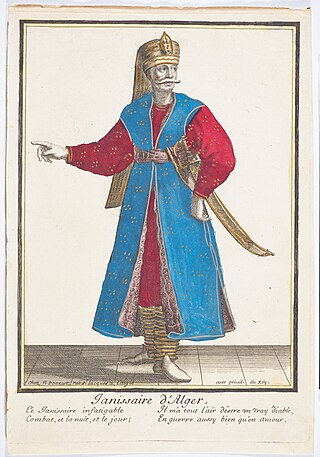
Dey, from the Turkish honorific title dayı, literally meaning uncle, was the title given to the rulers of the Regency of Algiers (Algeria), Tripoli, and Tunis under the Ottoman Empire from 1671 onwards. Twenty-nine deys held office from the establishment of the deylicate in Algeria until the French conquest in 1830.

The Regency of Algiers was a largely independent early modern Ottoman tributary state on the Barbary Coast of North Africa from 1516 to 1830. Founded by the privateer brothers Aruj and Hayreddin Reis, also known as Oruç and Khayr ad-Din, the Regency succeeded the crumbling Kingdom of Tlemcen as an infamous and formidable pirate base that plundered and waged maritime holy war on European Christian powers. Ottoman regents ruled as heads of a stratocracy; an autonomous military government controlled by the janissary corps, themed Garp ocaklarılit. 'Western Garrison' in Ottoman terminology.

Hussein Dey was the last Dey of the Deylik of Algiers.

Ali V Ben Ahmed, nicknamed Ali Khodja, Ali-Meguer, or Ali Loco was a Kouloughli of partial Georgian (Mengrelian) and Native Algerian origins born in Algeria. He was the dey of the Deylik of Algiers from September 1817, just after the assassination of his predecessor Omar Agha the 8th. He remained so until his death in February 1818. His sobriquet Ali-Meguer may indicate his Mingrelian background.

The Revolutions of Tunis or the Muradid War of Succession was a period of troubles and civil wars in Ottoman Tunisia. It ran from the death of the Muradid sovereign Murad II Bey in 1675 until the seizure of power by the Husainid sovereign Al-Husayn I ibn Ali at-Turki in 1705. The belligerents were Ali Bey al-Muradi and Muhammad Bey al-Muradi, their uncle Muhammad al-Hafsi al-Muradi, several Deys of Tunis, the Turkish militia in Tunis and the Dey of Algiers.
The Dey of Tunis was the military commander of the janissaries in the regency of Tunis. In the seventeenth century the holders of the position exercised varying degrees of power, often near-absolute. Until 1591 the Dey was appointed by the Ottoman governor (“Pasha”). In 1673 the Dey and the janissaries revolted against Murad II Bey and were defeated. After this the hereditary position of Bey was pre-eminent in Tunis. The position of Dey continued to exist until it was abolished by Sadok Bey in 1860.

The French-Algerian War of 1681–1688 was part of a wider campaign by France against the Barbary Pirates in the 1680s.

The "Odjak of Algiers" was a unit of the Algerian army. It was a highly autonomous part of the Janissary Corps, acting completely independently from the rest of the corps, similar to the relationship between Algiers and the Sublime Porte. Led by an Agha, they also took part in the country's internal administration and politics, ruling the country for several years. They acted as a defense unit, a Praetorian Guard, and an instrument of repression until 1817.

Baba Ali Chaouch, also known as Ali Soukali, or simply Ali I, was a ruler of the Deylik of Algiers from 1710 to 1718. He was the first dey of Algiers to be invested with the title of dey-pacha. The Sultan Ahmed III had Ali Chaouch's envoy given the caftan and the three tails, a sign of the dignity of a "pasha". This title was attributed to all his successors until 1830.
Mohamed ben Hassan or Muhammad III was the 12th ruler and Dey of Algiers. He ruled five months after his predecessor Baba Ali Chaouch.
The Maghrebi war (1699–1702) was a conflict involving a Tunisian, Tripolitanian, and Moroccan coalition, and the Deylik of Algiers. It was an important milestone in the further weakening of the already fragile Ottoman grip over the Maghreb, as both sides utterly ignored the Ottoman sultan's pleas to sign a peace treaty. This war also led to the renewal of the Muradid infighting, which would later lead to the establishment of the Beylik of Tunis, and the Husainid dynasty in 1705.
The Tunisian–Algerian War of 1705 was a conflict between the Regency of Algiers and the Regency of Tunis.
Hadj Ahmed Chabane Dey was the fourth Dey of Algiers. He ruled from 1688 to 1695, and was the first member of the Algerian Janissary Odjak to ever assume this position. Under his leadership, Algeria enjoyed good relations with France. His military campaigns against Morocco and Tunis were successful. However, his enemies turned his Eastern army against him; he was removed from power and executed.
Hadj Mustapha was the 7th ruler and Dey of Algiers. He ruled five years after his predecessor Hadj Chaouch.
Hadj Ahmed or Hadj Ahmed ben Hadj Massli was the 5th ruler and Dey of Algiers. He ruled two years after his predecessor Hadj Ahmed Chabane.
Hussein Khodja Dey or Hassan Khodja Dey was the 8th ruler and Dey of Algiers. He ruled one year after his predecessor Hadj Moustapha.
Mohamed Bektach was the 9th ruler and Dey of Algiers. He ruled three years after his predecessor Hussein Khodja Dey.
Baba Abdi or Kûr Abdi was the 13th ruler and Dey of Algiers. He ruled five months after his predecessor Mohamed Ben Hassen.

Sidi Hassan, also known as Hassan Pacha or Hassan III Pacha was the 17th ruler and Dey of Algiers. He ruled for 11 years after his predecessor Baba Mohammed ben-Osman.








